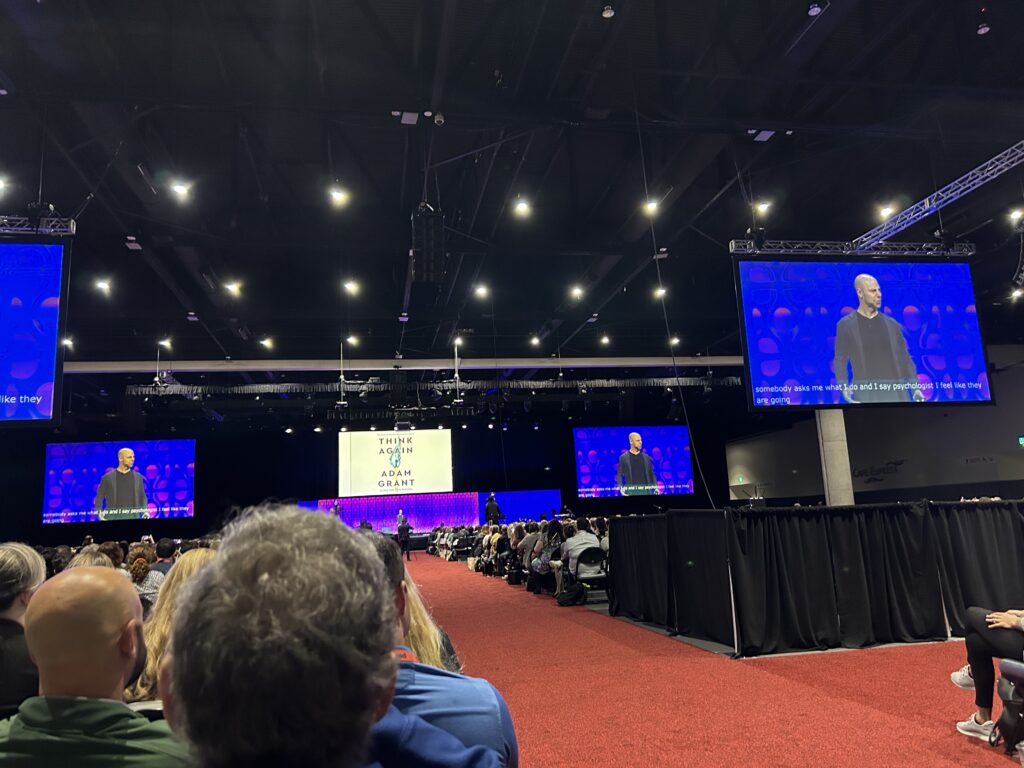Dispatches from ATD23: Monday
This week, the Axonify team is at the ATD International Annual Conference in San Diego! With star-studded keynotes, hundreds of educational sessions and the largest training expo floor in the industry, ATD23 is where countless trends in learning, development and frontline enablement are born.
Wondering what conversations and topics are making waves? Here are five of the trends we saw—and overheard—on the show floor today.
Reacting to change with un-learning and re-development
The speed of change was a constant conversation at the show. “Nothing is static,” said training consultant Steve Woodruff of Impactiviti. “As soon as you have best practices, you need to think about better practices. Or, as our own JD Dillon put it, “Oh my gosh, do things change quickly.”
So how do we keep up? In his keynote address, organizational psychologist and bestselling author Adam Grant explored the idea of “rethinking and relearning” as the way to combat the ebbs and flows of the industry. “Your whole job as a leader is to watch the world change, and adapt,” he said. For example, he suggested starting to approach enablement more like scientists, and think of key events like product launches as experiments. Why? To start truly identifying what’s working and what’s not—and iterating quickly. “I think we should be abandoning our time-honored best practices,” said Grant.

Making frontline feedback a requirement
We could be entering a new world of feedback culture. In Grant’s keynote, he said the way to navigate this fresh terrain is to build a “challenge network” of people willing to be brutally honest with you—and then instil the psychological safety to let the radical candor fly. That psychological safety is predicated on welcoming all types of feedback—gone are the days of the “don’t bring me problems, bring me solutions” mantra. “If people only speak up when they have solutions, you’ll never hear about the biggest problems,” explained Grant.
He also talked about the idea that feedback from employees shouldn’t just be welcomed, it should be required. He used the example of Admiral William McRaven, who would tell his people that it was their job to tell him when he was making mistakes. “He’d say ‘My job is to solve problems, and I can’t do that if you don’t tell me the problems,’” explained Grant.
It begs the question: what if we brought that approach to feedback to frontlines? How can organizations instil a high enough level of psychological safety, trust and engagement that they could make it a requirement for workers to share their thoughts?
The secret to buy-in: Bookending, problem-solving and time
Our Chief Learning Officer JD Dillon sat down with Nate Sadow, Senior Leader of Talent Development at Kroger, to talk about getting stakeholder buy-in on new L&D ideas, and they unearthed three key takeaways. First, to get buy-in from your C-Suite, you need to first bring in your frontline—effectively bookending your buy-in. Sadow shared how when Kroger launched Axonify, the frontline workers in the pilot stores actually helped to sell the idea of the platform to their C-Suite.

Getting buy-in is also about positioning. Instead of talking to stakeholders and influencers about learning strategy, talk about solving problems. “There’s no better way to help managers buy in than helping them do their jobs better,” said Dillon. And finally, it’s also important to remember it’s not a one-and-done process. With modern L&D ideas, there needs to be a constant re-enablement of stakeholders to ensure you continue to have their support and buy-in.
Internal mobility and skills
No surprise here: Upskilling and AI were two of the buzziest words on the show floor. But how they both connected back to internal mobility created an interesting trifecta. Of course, hIring from within isn’t a new concept, but in the frontline world it’s getting a lot more attention. There’s so much value to developing and upskilling frontline workers to prepare them to move into management, and as talent shortages continue to impact operational success, the need to mitigate voluntary turnover remains high. As one attendee said, “Upskilling is now mandatory to offer employees if you don’t want them to leave.”

Sophisticated data, but make it simple
More than one session called out the antiquated metrics that are often the bane of L&D’s existence. In their session, Dillon and Sadow talked about the layers of data that organizations can use to measure training and learning programs. Before, training was based on participation metrics. Now organizations go deeper with knowledge growth. And the most sophisticated companies are finding ways to tie these efforts to organizational and operational KPIs. As one attendee noted, “it all comes down to data.”
The need to share and socialize those sophisticated metrics, but in an easy-to-understand way, was a common refrain show. In a session on measuring impact, Louise Cosgrove, Learning Experience Standards and Analytics Lead at Emirates Airline, talked about the importance of making the impact of learning accessible to all their stakeholders by translating it out of L&D speak so it’s universally understood. “Everyone needs to know what impact looks like,” she said.
Stay tuned for more whispers, murmurs and musings we overhear from the show floor!